The Best Domain Name Generators: A Founder's Guide to Strategic Naming
Discover the best domain name generators to boost your branding in 2025. Find the perfect tool to create catchy, professional domain names easily.
Finding an available domain is easy. Finding one that sounds like a brand that’s the real game.
Most founders start their naming process by plugging a keyword into a generator, scrolling through hundreds of clunky options, and settling for whatever is available. This approach is backward. It treats naming as a search for an empty parking spot, not the strategic foundation of a brand identity.
A domain name generator is a powerful tool for ideation, but it's not a brand strategist. You need a framework to turn a list of available URLs into a defensible, memorable brand. This guide reframes how to use the best domain name generators as one part of a strategic process. We’ll show you how to generate ideas that feel deliberate, not desperate, and turn a simple domain search into a core branding exercise.
For founders who want to skip the trial-and-error, we built to bridge the gap between random generation and strategic naming.
Key Takeaways
Strategy Before Tools: A naming brief defining your brand's position, audience, and tone is non-negotiable. Without it, generators produce noise, not names.
Generators Have Specialties: Use tools for their intended purpose. LeanDomainSearch is for volume; Nameworm is for strategic, brand-first options; marketplaces like BrandBucket are for pre-vetted, premium names.
Availability ≠ Viability: An available domain is just the first step. The real work is screening for memorability, linguistic clarity, and, most critically, trademark conflicts.
A Domain Is Not a Brand: A brand is an asset built on emotion, trust, and distinction. The domain is just the address. Strategy turns a URL into a brand.
What Domain Generators Actually Do (and Don't Do)
At their core, domain generators are simple algorithms. They take your "seed" keywords and combine them with common prefixes (get, my, the), suffixes (ly, ify, able), and related terms to produce a high volume of potential domain names. They then ping a domain registry database to see which ones are available.
What they are good for: Speed, volume, and breaking creative blocks. They can generate hundreds of ideas in seconds.
What they are not good for: Strategy, legal screening, and brand alignment. They don't understand your positioning, your audience, or the emotion you want to evoke.
Relying on them blindly leads to generic, forgettable, or legally risky names. A name like CloudTechSolutions.com might be available, but it's not a brand. It's a description.
The Right Way to Use Domain Name Generators: A 5-Step Framework
Use these tools to augment your strategy, not replace it.
Start with a Strategic Brief: Before you open a single tool, define your brand. Who is your audience? What emotion do you want to evoke (e.g., trust, speed, luxury)? What is your core value proposition?
Select 3-5 Seed Concepts (Not Just Keywords): Instead of "AI marketing," try concepts like "amplify," "nexus," "growth," or "signal." Explore metaphors (e.g., "compass," "launchpad") and abstract ideas that capture your brand’s tone.
Generate and Iterate: Use your seed concepts in a few different generators to get a wide range of ideas. Don't look for the perfect name yet. Look for patterns, interesting word parts, and novel combinations.
Prioritize
.com, but Be Strategic with TLDs: A.comis still the gold standard for trust and authority. However, alternative TLDs can be strategic..ai/.io: Signal a tech-forward or SaaS company..co: A modern, global alternative to.com..app: Explicitly for applications.
Screen Ruthlessly Before Committing: This is the most critical step. Once you have a shortlist, run it through this checklist:
Memorability: Is it easy to say, spell, and recall after hearing it once?
Linguistic Check: Does it have unintended negative meanings in other languages or cultures?
Trademark Pre-Screen: Conduct a preliminary search on the USPTO's TESS database (or your country's equivalent). This is not legal advice, but it's an essential first filter.
The Best Domain Name Generators (by Use Case)
There is no single "best" tool. The right one depends on your goal. Here’s how they stack up.
For AI-Generated & Brandable Options
These tools go beyond simple word mashing to create more strategic, brand-like names.
1. Nameworm.ai
Nameworm is a comprehensive naming platform, not just a generator. It combines AI models (GPT, Claude, Gemini) with human-calibrated brand strategy to deliver names that are meaningful and strategically sound. You start with a detailed brief, and the platform delivers a curated list of names, each with a strategic rationale, tagline, domain availability check, and a preliminary USPTO trademark assessment. It’s an agency-style output at a tool’s price point.
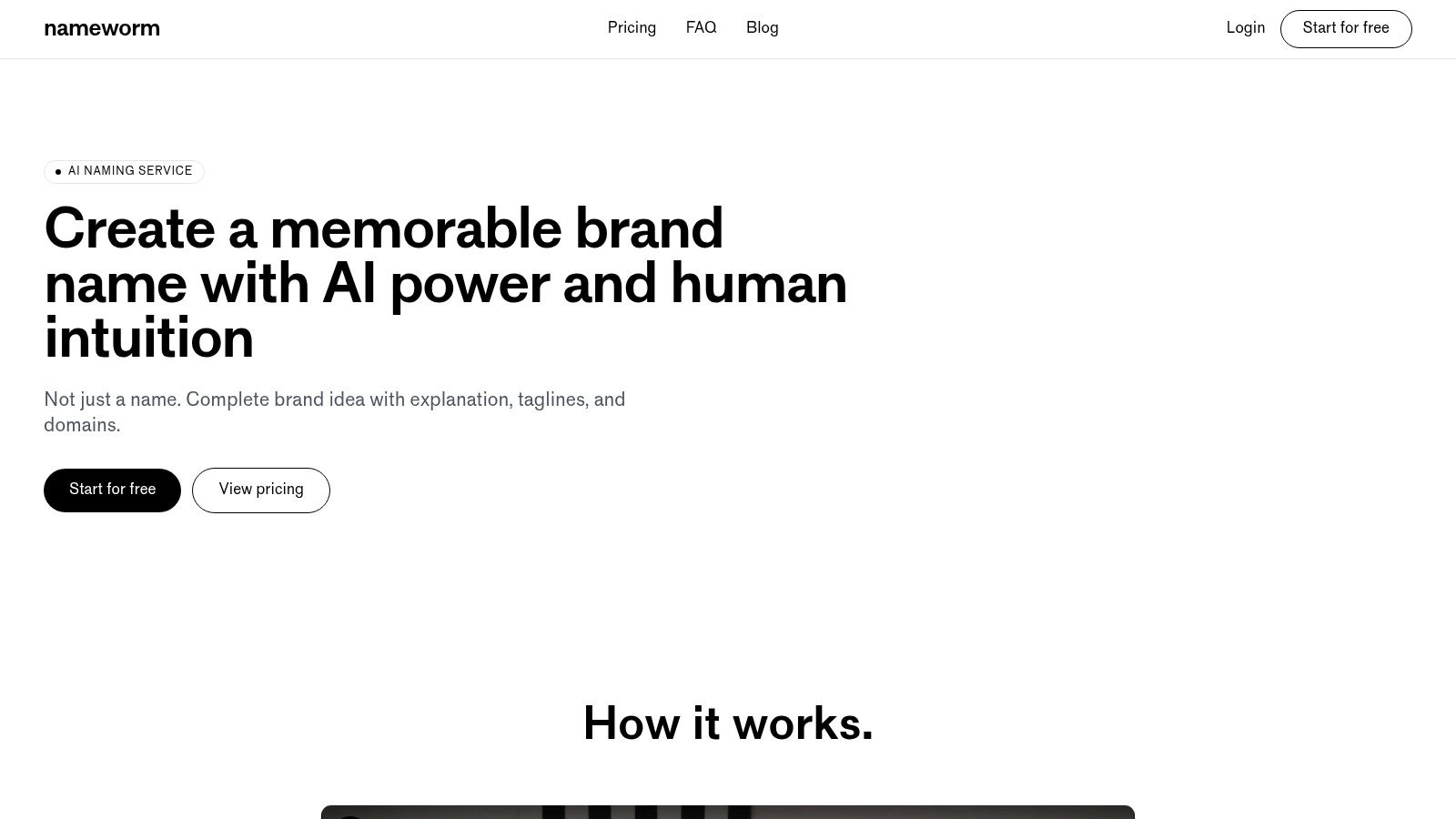
Best for: Founders who value strategy and want a complete naming package, not just a URL.
Price: Tiered plans from $49 to $139.
Website: https://www.nameworm.ai
2. Namelix & Looka
These platforms use AI to generate short, brandable names that are often abstract or invented. They are excellent for finding modern, tech-sounding names and often integrate with logo generators.
Caselet: Before & After AI Naming
Scenario: A B2B SaaS founder needed a name for their new project management tool. Their initial idea was
TaskFlowPro.com.Problem: Generic, forgettable, and a high risk for trademark conflicts. A generator spat it out, but it had no brand equity.
Process: The founder used their brand brief ("collaboration," "clarity," "momentum") as a seed for an AI tool.
Result: The tool generated "Cohesion". It was short, memorable, evoked teamwork, and
Cohesion.appwas available. The ".app" TLD reinforced its product category. This strategic pivot turned a descriptive label into a brand asset.
For Quick Ideas & Volume
These tools are built for speed and are great for initial brainstorming.
3. Lean Domain Search (by Automattic)
Enter a keyword, and it instantly combines it with thousands of common prefixes and suffixes to find available .com domains. It’s fast, simple, and perfect for generating a high volume of ideas.
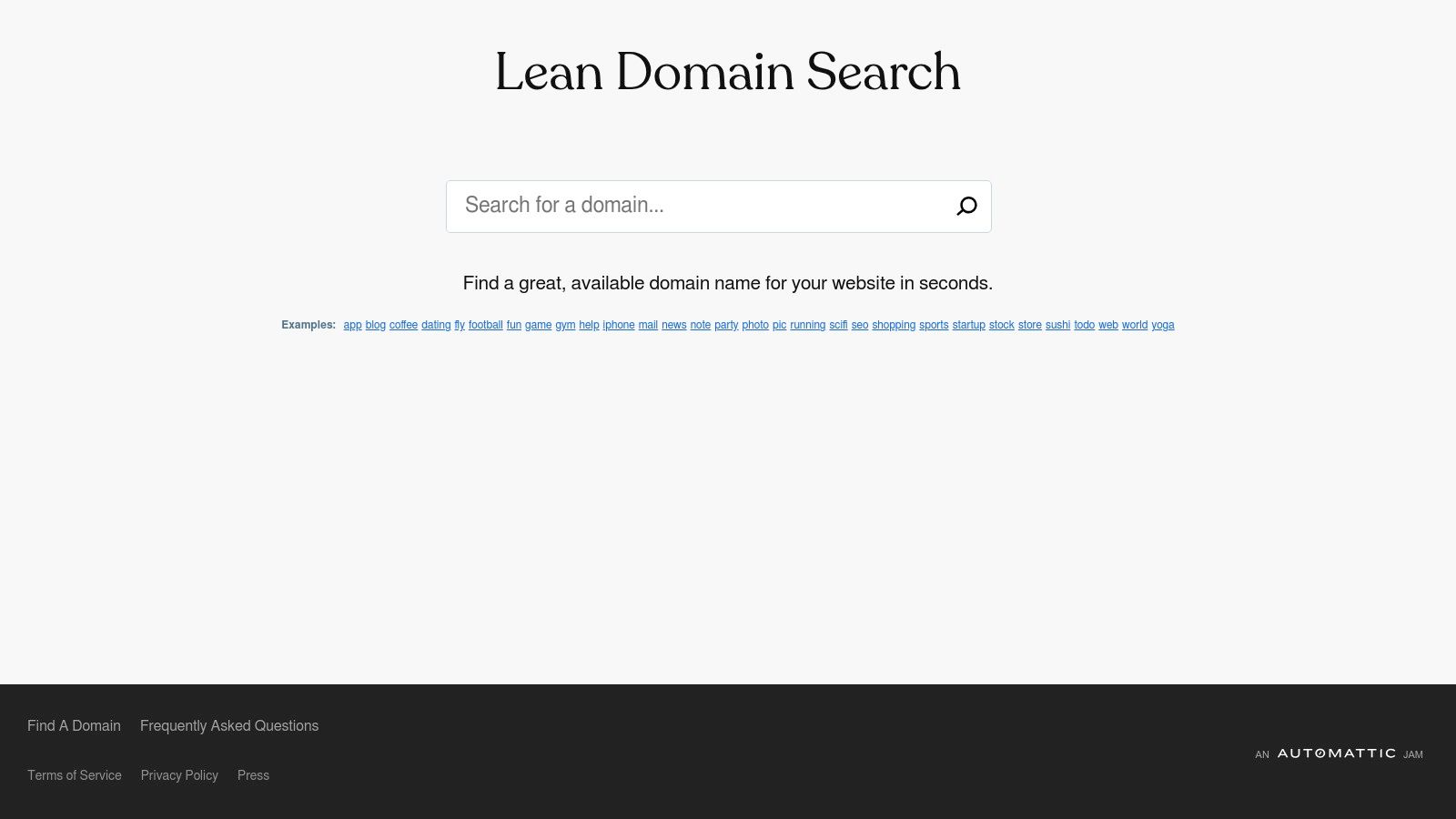
Best for: Rapid brainstorming when you have a core keyword.
Website: https://leandomainsearch.com
4. NameMesh (Currently Unavailable, but historically notable)
NameMesh was famous for its categorized results, showing you SEO-friendly names, short names, fun names, and new TLD options in different buckets. It was a founder favorite for its organized output.
For Checking TLD Availability
These tools are optimized for one thing: checking if a domain is available, fast.
5. Instant Domain Search
It checks domain availability across thousands of TLDs as you type. This real-time feedback loop is invaluable for quickly validating ideas during a brainstorming session.
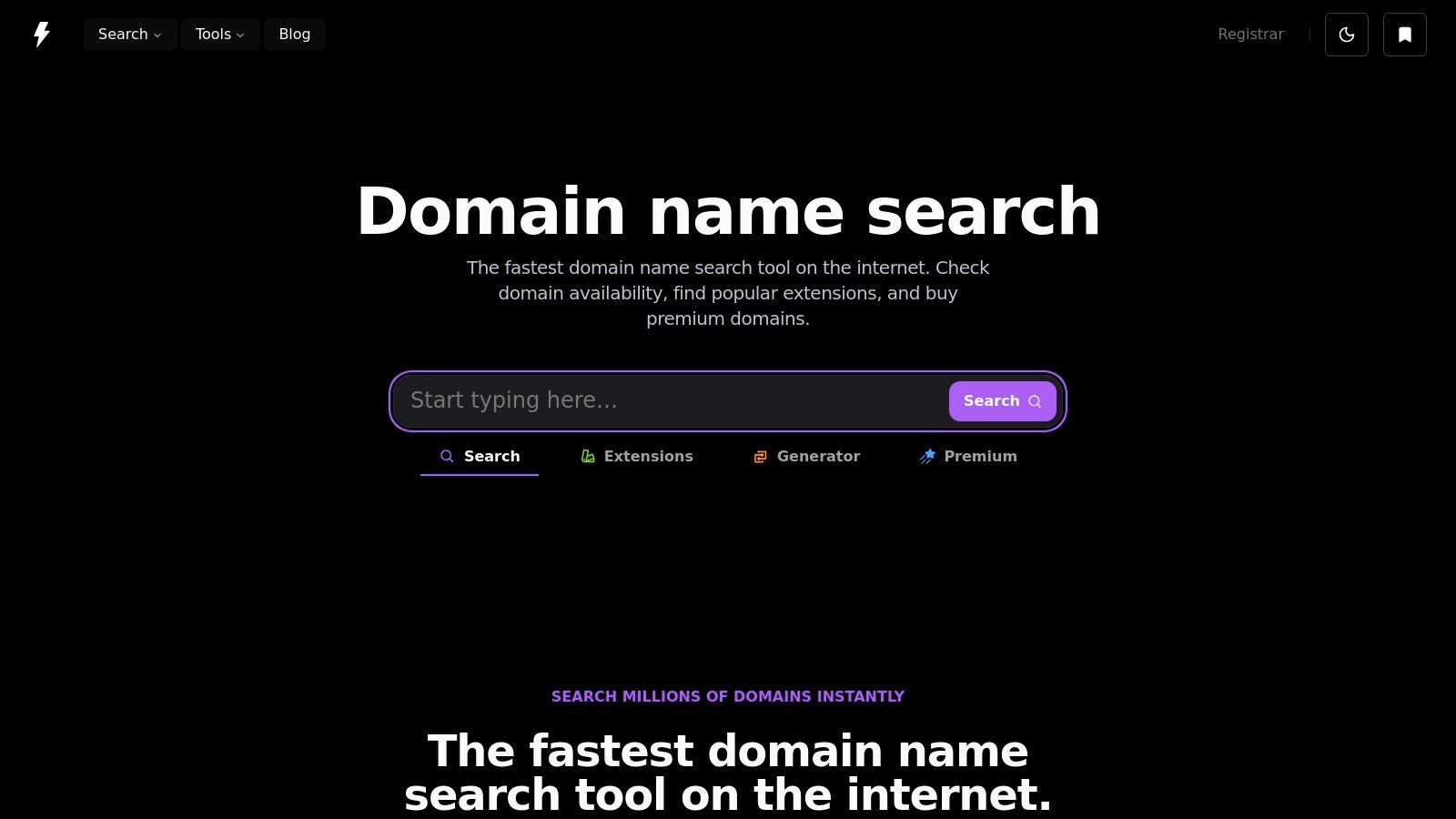
Best for: Verifying ideas on the fly and exploring alternative TLDs.
Website: https://instantdomainsearch.com
6. DomainWheel
Combines a quick availability check with creative AI prompts, offering names that rhyme or sound similar to your keyword. Good for breaking out of a creative rut.
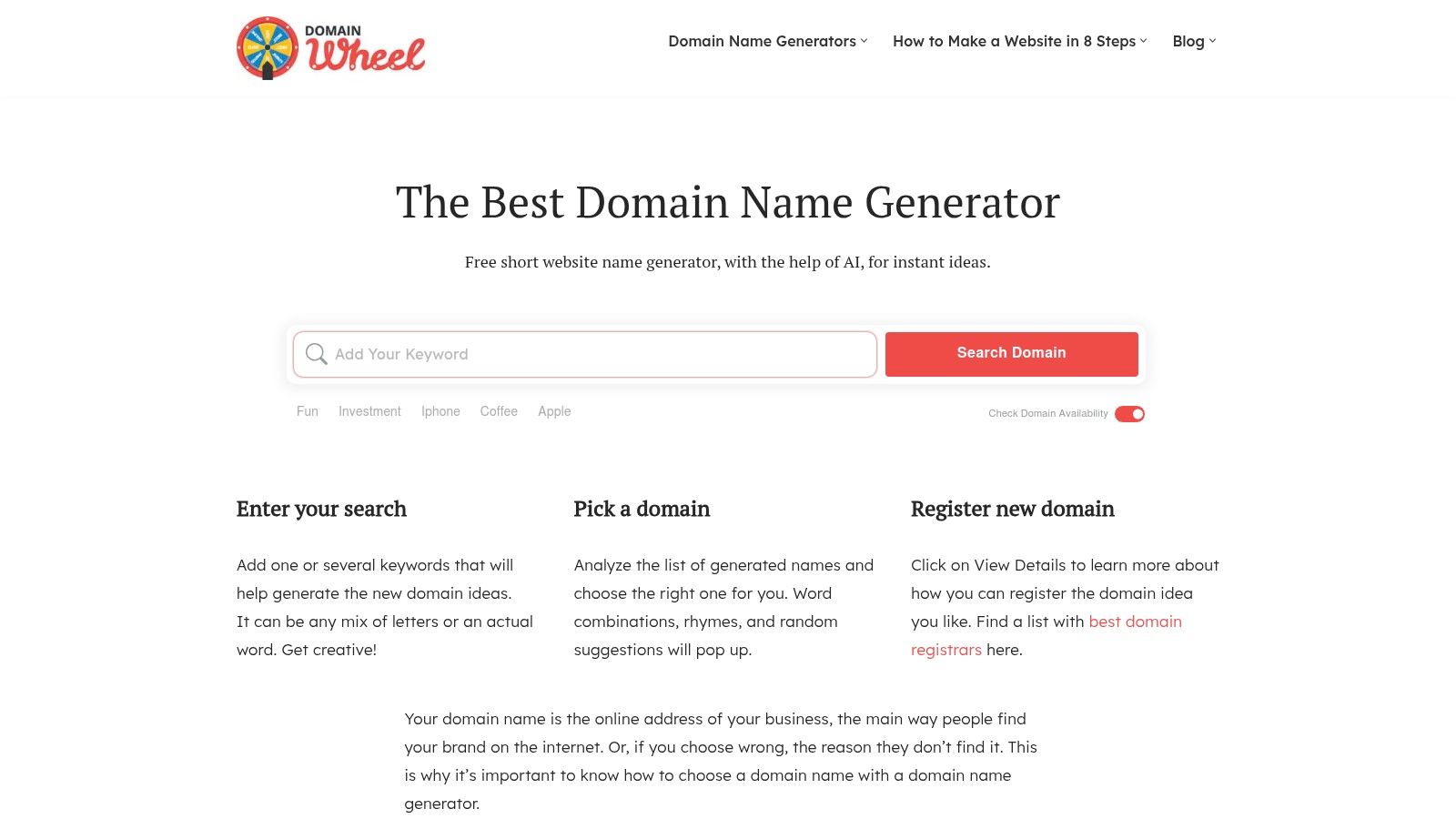
Best for: Creative exploration alongside practical checks.
Website: https://domainwheel.com
For Brandable Names & Marketplaces
For founders who are willing to invest in a premium, pre-vetted brand name.
7. BrandBucket
A curated marketplace of high-quality, brandable .com domains that have been hand-picked by naming experts. Each purchase includes a logo.
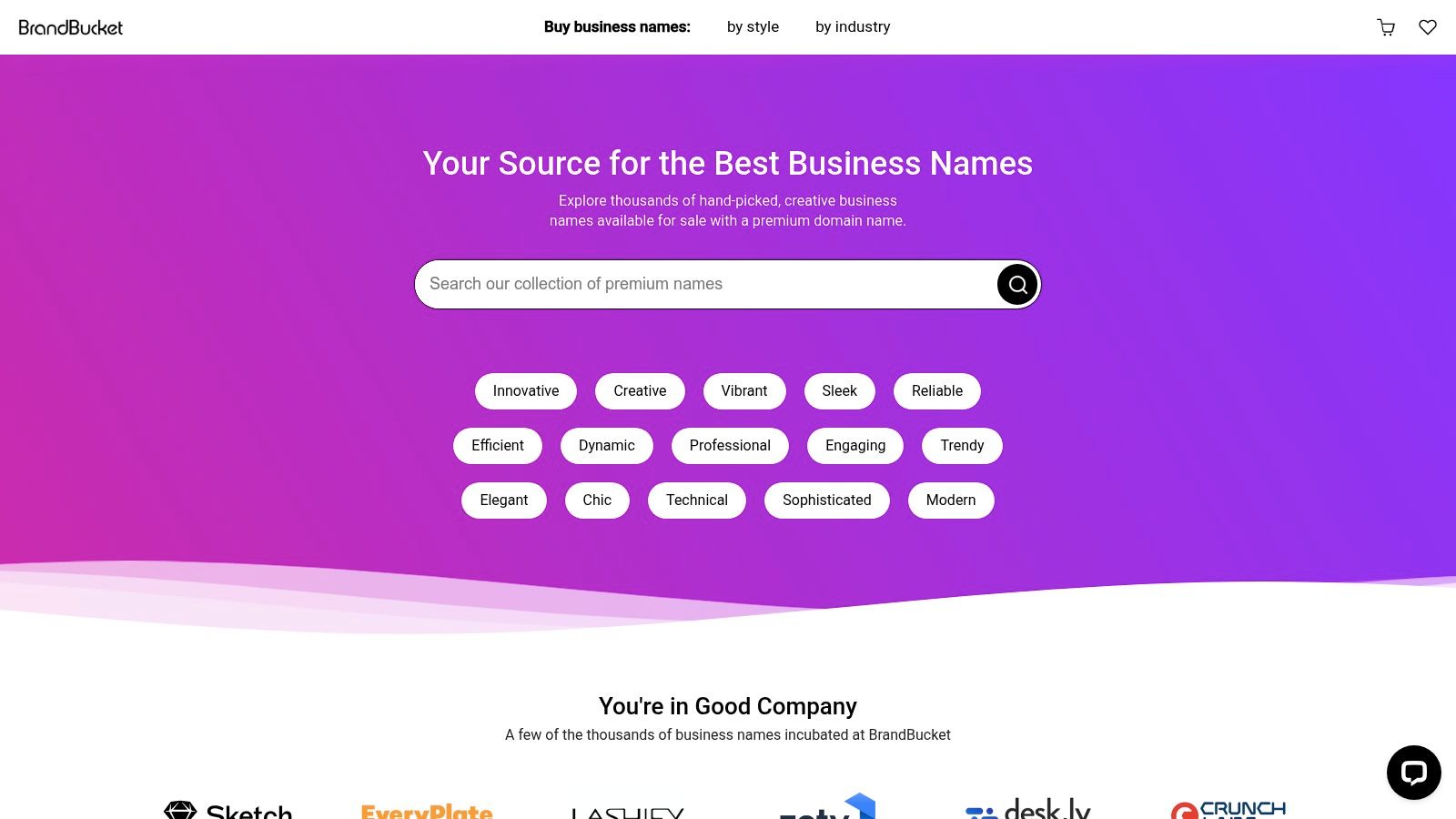
Best for: Startups needing a memorable, professional name with a logo, ready to go.
Website: https://www.brandbucket.com
8. Atom (formerly Squadhelp)
Similar to BrandBucket, Atom is a marketplace for premium domains. It also offers crowdsourced naming contests, allowing you to have hundreds of creatives submit ideas.
Best for: Founders who want to explore both marketplace and crowdsourcing options.
Website: https://www.atom.com
Other Notable Tools
Namecheap “Beast Mode”: A powerful bulk search tool for checking up to 5,000 domains at once. For power users and domain investors.
GoDaddy Domain Name Generator: Integrates name search directly into the world's largest registrar, offering a streamlined path to purchase and setup.
Shopify Business Name Generator: Designed for e-commerce entrepreneurs, it suggests retail-focused names and checks for
.comavailability.Nameboy: One of the oldest and most straightforward generators, good for classic keyword combinations.
Bluehost AI Domain Name Generator: A simple, integrated tool for those planning to host with Bluehost.
Panabee: A creative tool that checks domain, app store, and social media handle availability simultaneously.
Pitfalls & Gotchas: Common Naming Mistakes to Avoid
Many founders fall into the same traps. Here's what to watch for.
Mistake | Why It's a Problem | How to Avoid It |
|---|---|---|
Ignoring Trademarks | Thinking an available domain equals a clear brand. Wrong. Dead wrong. A trademark owner can force you to rebrand, costing you thousands. | Conduct a preliminary search on the USPTO's TESS database before you buy the domain. If you're serious about the name, consult a trademark attorney. |
Choosing Hard-to-Spell/Say Names | If customers can't find you, you don't exist. Clever spellings (e.g., | Use the "radio test": if you heard the name on the radio, could you spell it correctly without seeing it? Stick to intuitive spellings. |
Picking Generic, Meaningless Combos |
| Focus on evocative, metaphorical, or invented names that hint at your value without being blandly descriptive. Think Nest (security, comfort), not SmartHomeThermostats. |
Creating Awkward Pronunciations or Double Meanings | Names can create unintended words or phrases. Examples: | Say the name out loud. Have several people from different backgrounds read it and say it back to you. Check for linguistic and cultural conflicts if you plan to go global. |
Final Thought: Generators Give You Words. Strategy Turns Them into Brands.
You can't outsource brand creation to an algorithm. The best domain name generators are powerful creative partners, but they are only as good as the strategic direction you provide. The real work happens before you type a single keyword and after you get the results. It's in the careful consideration of your audience, the ruthless screening for legal risks, and the commitment to a name that does more than just fill a space on the internet—it tells a story.
Ready to move from a random list to a strategic choice? {{cta}} combines naming logic, domain checks, and creative direction in one flow, helping you find a name that's not just available, but viable.
Next Steps Checklist
Create a 1-Page Naming Brief: Define your audience, brand personality, core values, and 3-5 emotional keywords.
Select Two Generators: Pick one for volume (like Lean Domain Search) and one for brandability (like Nameworm or Namelix) to generate a long list.
Create a Shortlist of 5-10 Names: Run your long list through the memorability, spelling, and "radio test" filters.
Conduct a Preliminary Trademark Screen: Use the free USPTO TESS database to check your shortlisted names for obvious conflicts in your industry class.
Get Feedback: Share your final 2-3 options with trusted advisors or a small sample of your target audience to check for unforeseen issues before you commit.